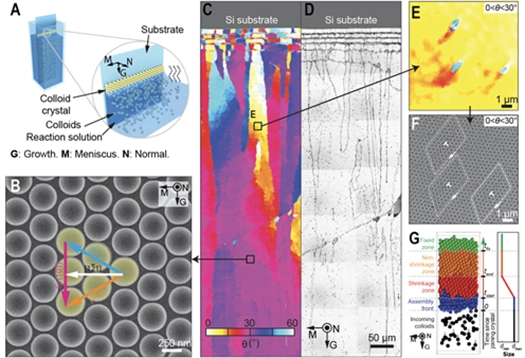Texture Development during Evaporation-Induced Colloidal Crystallization

Colloidal crystals — highly ordered structures formed by colloidal particles (0.1-10 um) — represent a versatile platform for applications that include photonics, catalysis, and chemical /biosensing. Evaporation-induced self-assembly is widely used to obtain large-scale colloidal crystals. However, the underlying mechanisms that lead to crystal growth along preferred directions are currently elusive.
A multidisciplinary research team from the Harvard MRSEC, led by Aizenberg, Brenner, and Spaepen, has integrated experiment, theory, and computational modeling to uncover the microscopic origins of texture development during evaporative self-assembly. While the close-packed direction in nucleated crystals is both controlled by and parallel to the local meniscus, all colloidal crystal grains undergo a gradual crystallographic rotation facilitated by mechanical stress-induced, geometrically necessary dislocations to achieve a uniform crystallographic orientation with a close-packed direction parallel to the growth direction.
Publication:
L. Li, C. Goodrich, H. Yang, K.R. Phillips, Z. Jia, H. Chen, L. Wang, J. Zhong, A. Liu, J. Lu, J. Shuai, M.P. Brenner, F. Spaepen, and J. Aizenberg, "Microscopic origins of the crystallographically preferred growth in evaporation-induced colloidal crystals," P. Natl. Acad. Sci. USA 118 (32), e2107588118 (2021) ![]()
![]()
Frans Spaepen��� (Material Science) and David A. Weitz (Physics & Applied Physics)
2021-2022 Harvard MRSEC (DMR-2011754)
